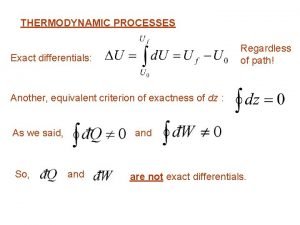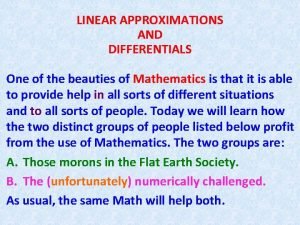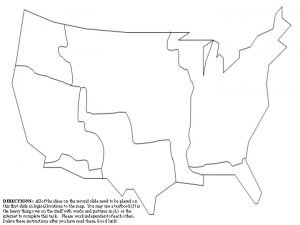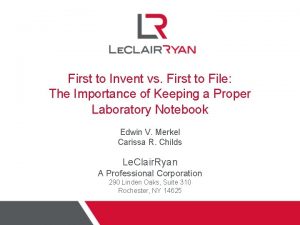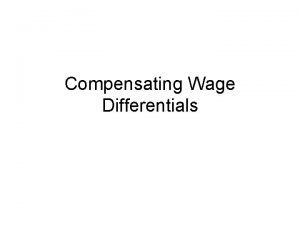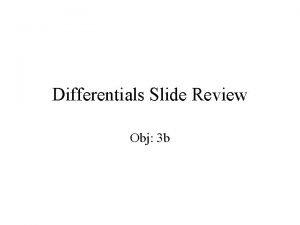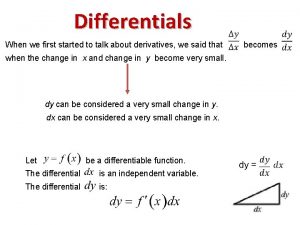Differentials Intro The device on the first slide





























































- Slides: 61

Differentials


Intro • The device on the first slide is called a micrometer…. it is used for making precision measurements of the size of various objects…. . a small metal cube, the diameter of a ball bearing, etc…. • However, even a precision instrument like a micrometer has an error in measuring things….

• Errors in measurement, like a small error in the diameter of a ball bearing, can lead to major problems in an engine, if the ball bearing’s size is too far off from it’s allowed variation.

• To measure the precise change in a mathematical function, such as a change in an equation, we use Δy, the change in y. • But this can be messy to calculate ……. it would be nice to use a simpler way to represent the change in y, and using Calculus, we can !!!

After this lesson, you should be able to: • Understand the concept of a tangent line approximation. • Compare the value of the differential, dy, with the actual change in y, Δy. • Estimate a propagated error using a differential. • Find the differential of a function using differentiation formulas.

Δx xΔx (Δx)2 A Simple Example x Let S(x) be the area of a square of side length x. Or, S(x) = x 2 x Now we give the side a change Δx , then the corresponding change of area will be ΔS = S(x + Δx) – S(x) = (x + Δx)2 – x 2 = 2 xΔx + (Δx)2 Compare with Δx , (Δx)2 is the infinite smaller change. Or, xΔx Differentials Δx

Δx xΔx (Δx)2 A Simple Example For any function of g(Δx), if x xΔx Differentials Δx x We call g(Δx) is higher order of infinitesimal of Δx, denoted as ε(Δx). In other words, the change of area can be approximated to the first part of ΔS = S(x + Δx) – S(x) = 2 xΔx + (Δx)2 = 2 xΔx + ε(Δx) The first part above is linear to Δx. We call the first part as “Linear Principal Part ”.

Try This Find the equation of the line tangent to (1, 1). at (1, 1)

Analysis x 0. 9 1. 0 1. 1 f(x) y Complete the table (1, 1)

Analysis x 0. 9 1. 0 1. 1 f(x). 81 1 y . 8 1 1. 2 Complete the table (1, 1)

Linear Approximation to a Function Linear Approximation or TANGENT LINE!!!!!

Important Idea The equation of the line tangent to f(x) at c can be used to approximate values of f(x) near f(c).

Definition of Differentials

In many types of application, the differential of y can be used as an approximation of the change of y. y = f(x) =x 2 y = 2 x + 1 or f(x+Δx) ε(Δx) dy (1, 1) Δx f(x) Δy or

Animated Graphical View • Note how the "del y" and the dy in the figure get closer and closer











Example 1 Find dy for f (x) = x 2 + 3 x and evaluate dy for x = 2 and dx = 0. 1.

Example 1 Find dy for f (x) = x 2 + 3 x and evaluate dy for x = 2 and dx = 0. 1. Solution: dy = f ’(x) dx = (2 x + 3) dx When x = 2 and dx = 0. 1, dy = [2(2) + 3] 0. 1 = 0. 7.

Derivatives in differential form Function derivative differential y=xn y ’ = n x n-1 dy = n x n-1 dx y = UV y ′ = UV ′ + VU ′ dy = U d. V + V d. U y= U V y ’ = V U′ – U V′ V 2 dy = V d. U – U d. V V 2

Finding Differentials Function y = x 2 y = 2 sin x y = x cosx Derivative Differential

Finding Differentials Function y = x 2 y = 2 sin x y = x cosx Derivative Differential

Finding Differentials Function y = x 2 y = 2 sin x y = x cosx Derivative Differential

Finding Differentials Function y = x 2 y = 2 sin x y = x cosx Derivative Differential

Finding Differentials Function y = x 2 y = 2 sin x y = x cosx Derivative Differential

Finding Differentials Function y = x 2 y = 2 sin x y = x cosx Derivative Differential

Finding Differentials Function y = x 2 y = 2 sin x y = x cosx Derivative Differential

Try This Find the differential dy of the function:

Linear Approximation to a Function Linear Approximation or TANGENT LINE!!!!!

Find the tangent line approximation of at the point (0, 1).

Find the tangent line approximation of at the point (0, 1).

Example 1 Find the approximate value of the cubic root Solution Let’s consider the function Δx = 0. 02, then and set x = 1,

Example Practice Find the approximate value of square root Solution Let’s consider the function Δx = – 0. 02, then and set x = 49,

Example 1 • Estimate ( 64. 3 ) Let y= (x) 1/3 64. 3 = 64 + 0. 3 Let x = 64 and Δx = 0. 3 = 3/10 So y + Δy ≈ y + dy and y + dy = ( 64 ) 1/3 dy = 1/3 x + 1/3 ( 64 ) -2/3 – 2/3 ( 3/10 ) = 4 + 1/3 ( 1/16 ) ( 3/ 10 ) dx

• = 4 + 1 / 160 = 4 By calculator, ( 64. 3 ) 1 = 4. 00625 160 1/3 = 4. 00624026 Not bad…. considering they had no calculator back then !!!

Error Propagation Physicists and engineers tend to make liberal use of the approximation of Δy by dy. One way this occrus in practice is in the estimation of errors propagated by physical measuring devices. x – measured value of a variable x + Δx – the exact value Δx – the error in measurement Measured Value Measurement Error If the measured value x is used to compute another value f(x), then Propagated Error f(x + Δx) – f(x) = Δy Exact Value

Propagated Error • Consider a rectangular box with a square base 2 x – Height is 2 times length of sides of base x x – Given that x = 3. 5 – You are able to measure with 3% accuracy • What is the error propagated for the volume?

Propagated Error • We know that • Then dy = 6 x 2 dx = 6 * 3. 52 * 0. 105 = 7. 7175 This is the approximate propagated error for the volume

Propagated Error • The propagated error is the dy – sometimes called the df • The relative error is • The percentage of error – relative error * 100%

Example 2 The radius of a sphere is measured to be 6 inches, with a possible error of 0. 02 inch. Use differentials to approximate the maximum possible error in calculating (a) The volume of the sphere (b) The surface area of the sphere (c) The relative errors in parts (a) and (b) Solution It is obvious that from the given information r = 6 inches and Δr = dr = ± 0. 02 inches (a) in 3

Example 2 The radius of a sphere is measured to be 6 inches, with a possible error of 0. 02 inch. Use differentials to approximate the maximum possible error in calculating (a) The volume of the sphere (b) The surface area of the sphere (c) The relative errors in parts (a) and (b) Solution It is obvious that from the given information r = 6 inches and Δr = dr = ± 0. 02 inches (b) in 2

Example 2 The radius of a sphere is measured to be 6 inches, with a possible error of 0. 02 inch. Use differentials to approximate the maximum possible error in calculating (a) The volume of the sphere (b) The surface area of the sphere (c) The relative errors in parts (a) and (b) Solution (c)

Calculating Differentials The differentiation rules we learned in Chapter 2 can be migrate to here Constant Multiple Sum or Difference Product Quotient

Calculating Differentials Don’t forget the chain rule in calculating the derivatives. The same rule is true in calculating the differentials

Example 3 Solution Find the differentials

Example 4 Solution Find the differentials

Example 5 Solution Find the differentials

Example 6 Find the differential dy in an implicit function if y is a function of x and Solution




 Heel toe dance
Heel toe dance Hardware output
Hardware output Hydrocephalus ddx
Hydrocephalus ddx Compensating differentials
Compensating differentials Hedonic wage theory
Hedonic wage theory Compensating wage differentials
Compensating wage differentials Exact differentials in thermodynamics
Exact differentials in thermodynamics Wage differentials definition
Wage differentials definition Fast and deep deformation approximations
Fast and deep deformation approximations Slide and divide steps
Slide and divide steps A tagout device is preferable to using a lockout device.
A tagout device is preferable to using a lockout device. Kelompok output
Kelompok output #slide=first
#slide=first Hát kết hợp bộ gõ cơ thể
Hát kết hợp bộ gõ cơ thể Frameset trong html5
Frameset trong html5 Bổ thể
Bổ thể Tỉ lệ cơ thể trẻ em
Tỉ lệ cơ thể trẻ em Gấu đi như thế nào
Gấu đi như thế nào Tư thế worms-breton
Tư thế worms-breton Hát lên người ơi alleluia
Hát lên người ơi alleluia Các môn thể thao bắt đầu bằng tiếng đua
Các môn thể thao bắt đầu bằng tiếng đua Thế nào là hệ số cao nhất
Thế nào là hệ số cao nhất Các châu lục và đại dương trên thế giới
Các châu lục và đại dương trên thế giới Công thức tính thế năng
Công thức tính thế năng Trời xanh đây là của chúng ta thể thơ
Trời xanh đây là của chúng ta thể thơ Mật thư anh em như thể tay chân
Mật thư anh em như thể tay chân 101012 bằng
101012 bằng Phản ứng thế ankan
Phản ứng thế ankan Các châu lục và đại dương trên thế giới
Các châu lục và đại dương trên thế giới Thơ thất ngôn tứ tuyệt đường luật
Thơ thất ngôn tứ tuyệt đường luật Quá trình desamine hóa có thể tạo ra
Quá trình desamine hóa có thể tạo ra Một số thể thơ truyền thống
Một số thể thơ truyền thống Cái miệng nó xinh thế
Cái miệng nó xinh thế Vẽ hình chiếu vuông góc của vật thể sau
Vẽ hình chiếu vuông góc của vật thể sau Nguyên nhân của sự mỏi cơ sinh 8
Nguyên nhân của sự mỏi cơ sinh 8 đặc điểm cơ thể của người tối cổ
đặc điểm cơ thể của người tối cổ Ví dụ giọng cùng tên
Ví dụ giọng cùng tên Vẽ hình chiếu đứng bằng cạnh của vật thể
Vẽ hình chiếu đứng bằng cạnh của vật thể Fecboak
Fecboak Thẻ vin
Thẻ vin đại từ thay thế
đại từ thay thế điện thế nghỉ
điện thế nghỉ Tư thế ngồi viết
Tư thế ngồi viết Diễn thế sinh thái là
Diễn thế sinh thái là Dạng đột biến một nhiễm là
Dạng đột biến một nhiễm là Thế nào là số nguyên tố
Thế nào là số nguyên tố Tư thế ngồi viết
Tư thế ngồi viết Lời thề hippocrates
Lời thề hippocrates Thiếu nhi thế giới liên hoan
Thiếu nhi thế giới liên hoan ưu thế lai là gì
ưu thế lai là gì Sự nuôi và dạy con của hổ
Sự nuôi và dạy con của hổ Khi nào hổ mẹ dạy hổ con săn mồi
Khi nào hổ mẹ dạy hổ con săn mồi Sơ đồ cơ thể người
Sơ đồ cơ thể người Từ ngữ thể hiện lòng nhân hậu
Từ ngữ thể hiện lòng nhân hậu Thế nào là mạng điện lắp đặt kiểu nổi
Thế nào là mạng điện lắp đặt kiểu nổi Maturity continuum model victories order
Maturity continuum model victories order State space search
State space search Sdl first vs code first
Sdl first vs code first Put first things first activities
Put first things first activities Habit 3
Habit 3 Entity framework 7 release date
Entity framework 7 release date First to invent or first to file
First to invent or first to file






